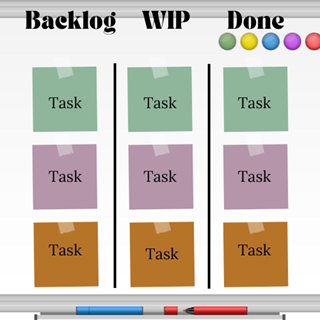The AGILE Philosophy: It’s Okay to Not Know What You’re Doing

Posted created by Karlie Kildall
Applied IMC (Winter 2023)
Are you new to the agile management process? Is your manager expecting you to pull work towards you instead of pushing it at you? It can feel overwhelming at first; especially when you’ve been taught in school to follow syllabi and do what the teacher says. Well I am here to tell you that it will get easier to implement agile processes into your daily life; eventually you’ll be so productive that you will be asking your manager for work!
First, there are a few concepts that you will need to become familiar with.
What is Agile?
Agile is an iterative approach to project management that helps teams deliver value to their consumers by working on and releasing small increments of work rather than mass production of a product. With the agile philosophy, teams are constantly checking in with each other to plan, review, and evaluate work. With the agile process teams focus their energy and resources on smaller tasks and deliverables rather than the overarching end product. This leads us to some components of agile:
1. The Sprint Development Life Cycle
The first component that you will need to become familiar with when using an agile approach is SCRUM or SDLC (sprint development lifecycle). With SDLC, work is broken down into sprints, small amounts of time where the team completes specific tasks.
- The SDLC starts with a sprint planning meeting where the product manager displays a list of deliverables that the team needs to accomplish. From there, the team begins to decide which deliverables it wants to work on for that sprint. The team, as they decide, moves these deliverables into the backlog of the Kanban. Then, they begin to break these deliverables down into smaller bits of work that make it clear what they need to get done in the sprint.
- The next part of the SDLC is the sprint execution, where the team is actually executing the work that they decided upon in the sprint planning meeting.
- After the execution, the team participates in a sprint review, in which they review the work they did during the sprint. The sprint review analyzes the deliverables that the team was able to accomplish.
- Finally, the last part of the SDLC is the sprint retro, where the team evaluates their process; at this point, the team should be refining their process to make the next sprint smoother.
A quick note about sprints: they can be as long or as short as needed, in the agile processes that I have been a part of they were typically about 2 weeks long. This timeline allows for the team to plan and execute the amount of work they think they can get done. The other additional benefit of a sprint, is it allows the team to have ever changing tasks to do which aids in productivity and decreases burnout.
2. The Kanban
Now, above I mentioned that during the sprint planning meeting the team moves the deliverables they want to work on into the Kanban backlog and you’re either thinking what the heck does that mean or yep got it! If you’re in the first group then don’t fret, I have written an entire blog on the Kanban process, check it out here. For that reason, I am not going to go into a lot of detail about the Kanban. In short, a Kanban is an agile framework that transparently displays work, member activity, and progress during the SDLC. The Kanban allows teams to see who is working on what tasks or deliverables and what stage the task is in.

What you need to do as a team member
The most important things you need to do as a member of a team using agile are:
- Come prepared with markers and sticky notes to use for the Kanban during the sprint planning meeting
- Don’t wait for your product manager to tell you what to do! That’s what the backlog of the kanban is for, you can easily see what work needs to be done, so do it
- Always be doing something for your team, work on small pieces day by day
- Communication is key
- It’s okay if the work isn’t perfect, doing is better then not doing
If you are still having trouble wrapping your mind around agile, here is a great video that visually demonstrates the process:
